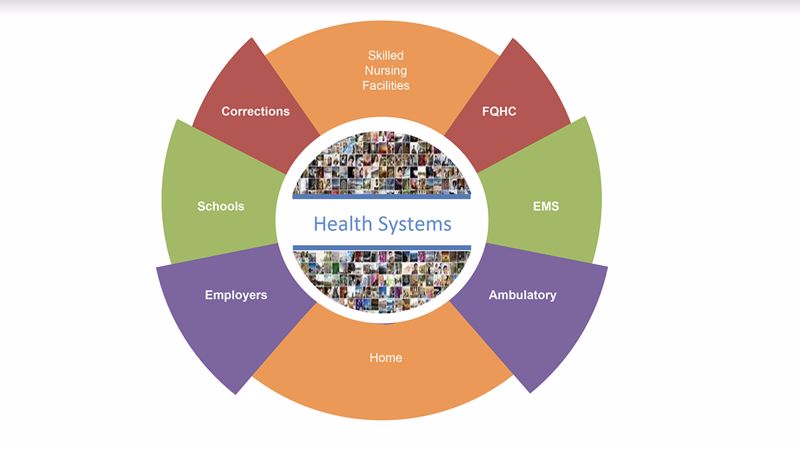Telehealth is a revolutionary solution that has changed the healthcare industry. It’s been a force over the last decade, but more recently since the coronavirus made its global impact. Telehealth has been a part of many healthcare organizations’ business strategies over the last decade, but now due to the effects of COVID-19, it has made its profound transformation. Telehealth is no longer a “nice to have” it is now a required pathway to delivering care. Meg Barron, vice president of digital innovation at the American Medical Association, reported that 60 to 90% of physicians use telehealth services since the start of the pandemic. Even before we had to make room for the “new normal,” telehealth visits and remote patient monitoring doubled between 2016 and 2019.
When many think of the use of telemedicine, however, it’s often associated strictly with video conferencing. But telehealth is so much more than that – the new normal for healthcare delivery is far and wide, expanding over several virtual care engagement modalities that can be highly beneficial during these strange times and beyond.
 The new normal for healthcare delivery is far and wide, impacting all avenues of the healthcare system.
The new normal for healthcare delivery is far and wide, impacting all avenues of the healthcare system.What does the digital transformation mean for healthcare?
The new normal of virtual care has pushed healthcare systems to now leverage digital technology, specifically telemedicine and telehealth, to expand access to care, drive high patient retention and increase revenue. The goal is to provide one entry point for a patient to receive care and then follow them through their care continuum journey at as many points as possible (from low acuity to high acuity care). This strategy complements a brick and mortar delivery model and allows healthcare providers to bring care to their patient versus them finding care elsewhere.
While a video conference is a great starting point for many telehealth visits, its ability to support a growing virtual care model is limited. There are additional patient engagement modalities that are quickly taking off to support this new pathway to care through their communities.
Virtual care engagement modalities that define telehealth
Encompassing multiple engagement modalities into your care delivery plan means increased patient satisfaction and new opportunities for reimbursable patient services.
Some of the virtual care engagement modalities that can be highly advantageous across the care spectrum include:
 Incorporating multiple telehealth modalities into your delivery model allows your health system to expand services.
Incorporating multiple telehealth modalities into your delivery model allows your health system to expand services.1. Messaging
Patients can reach out to care providers or clinical care teams for safe, secure conversation using a messaging application.
2. Urgent care
On-demand care applications allow patients to connect with a clinician anywhere, at any time and schedule a visit, or perhaps connect immediately for a virtual chat in urgent situations.
3. Scheduled appointments
Pre-determined appointments or encounters with clinicians allows for greater scalability and acuity.
4. Store-and-forward
This modality helps clinicians capture, store and transmit patient health information for asynchronous healthcare delivery via data storage and transmission technology. For example, information that’s stored, such as CAT scans, MRIs, X-rays and other photos, videos and text-based patient data can be sent to specialists to evaluate patients’ needs for treatment from afar.
5. Group session
Providers have the ability to virtually engage with multiple parties. This could be used for a session with more than one patient at a time, a patient and their family members, or a patient’s care/specialist team.
6. Provider-to-provider
Instead of waiting on hold on the phone to speak with another physician, providers can engage in a virtual meeting to discuss patient information in a secure, more intimate setting.
8. In-home visits
Allows for a wide range of services to be conducted at home, giving patients the option to remain in place in a comfortable setting. Services can include (but are not limited to) wound care, patient and caregiver education, intravenous therapy, injections and serious illness monitoring. Engagement could entail:
- Self-Assessment – The use of a broad range of wellness and clinical devices for the consumer/patient to measure vitals and wellness activities.
- Clinical Assist – Leveraging the skills of a clinically trained resource to assist in conducting a patient health assessment in partnership with the physician who is located in a remote location; however, participating in the encounter via a video service. The physician is able to view in real-time collected images, data, and audio to complete a high acuity assessment.
Expand your digital health care footprint
Incorporating the different telehealth modalities into your delivery of care practices allow your health system to expand services with greater opportunity to increase care access; coupled with reaching more vulnerable people in a shorter amount of time.
Key takeaways:
- The pathway to care is through digital technologies.
- Video-only modality was a great start, now it’s time to expand your offerings/engagements.
AMD Global Telemedicine provides a portfolio of telemedicine and telehealth solutions that help you scale your healthcare organization’s virtual care programs from low acuity (video only) to high acuity encounters (seamless integration of medical devices).
AGNES Connect®
A collaborative patient assessment tool for enterprise-wide telehealth applications. Leveraging our cloud-based infrastructure, healthcare systems can manage multiple telehealth sites and have one access point to deliver care in partnership with their local provider networks.






